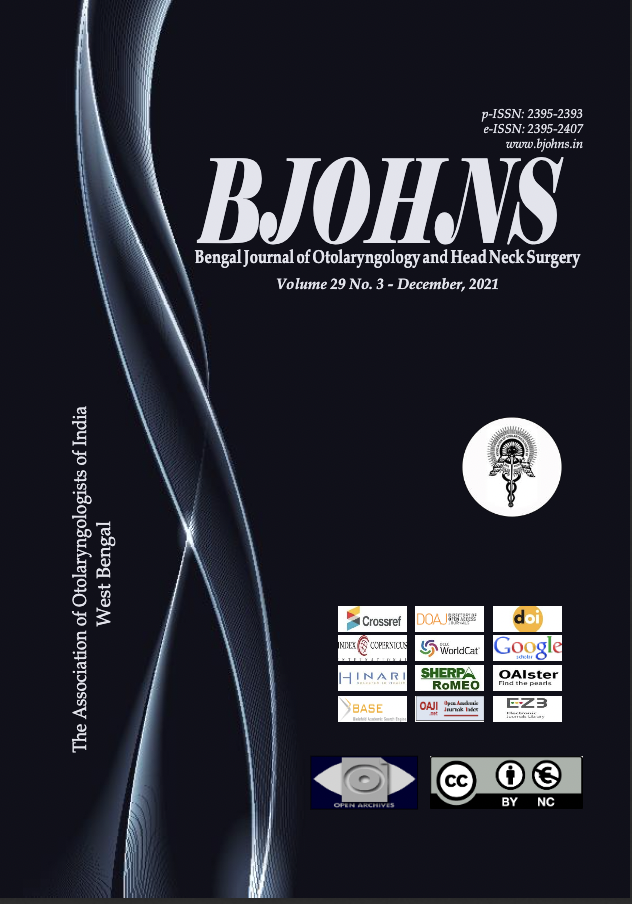Anthropometric Study of Nasal Parameters of South Indian Population
Main Article Content
Abstract
Introduction
The shape of the nose is a signature indicating the ethnicity, age, and sex of the person. Our aim is to map the range of various anthropometric parameters of nose in South Indians.
Materials and Methods
This study includes measurement and statistical analysis of different parameters of nose among 61 South Indian medical students (34 females;27 males) using digital Vernier calipers.
Results
The means of various parameters were- 1) Nasal Breadth -2.9cm (males) and 2.5 cm (females). 2) Nasal height-5 cm (males) and 4.9cm (females). 3) The nasofacial angle-37.9 degree (males) and 36.7 degree (females). 4) The nasolabial angle 115.2 degree (males) and 116.5 degree (females). 5) The nasofrontal angle 127.1 degree (males) and 134.7 degree (females). 6) The most common type of nose is leptorrhine in both males and females.
Conclusion
All the measurements can be used for evaluation of nasal deformity, treatment planning and post-surgical evaluation of the correction achieved during rhinoplasty.
Article Details

This work is licensed under a Creative Commons Attribution-NonCommercial 4.0 International License.
References
Sood VP. Corrective rhinoplasty.3rd edition. New Delhi: CBS Publishers and Distributors Pvt. Ltd,2013:17-18,28-29
Radha K, Srinivasan KR. Nasal index: A cross sectional study among South Indian population. Indian Journal of Clinical Anatomy and Physiology 2019; 6(2):201-4
Aung SC, Foo CL, Lee ST. Three dimensional laser scan assessment of the Oriental nose with a new classification of Oriental nasal types. Br J Plast Surg. 2000; 53:109-16.
Daniel B. Racial Anthropology and Genetics of the Lebanese. 2002. p. 1-2. Available from: http://www.phoenicia.org/ychromodrafteng.html.
Porter JP, Olson KL. Analysis of the African American female nose. Plast Reconstr Surg. 2003; 111:620-6
Farkas LG, Katic MJ, Forrest CR, Alt KW, Bagic I, Baltadjiev G, et al. International anthropometric study of facial morphology in various ethnic groups/races. J Craniofac Surg. 2005; 16:615-46
Uzun A, Akbas H, Bilgic S, Emirzeoglu M, Bostanci O, Sahin B, et al. The average values of the nasal anthropometric measurements in 108 young Turkish males. Auris Nasus Larynx 2006; 33:31-5
Oladipo GS, Olabiyi AO, Oremosu AA, Noronha CC. Nasal indices among major ethnic groups in Southern Nigeria. Sci Res Essays 2007; 2:20-2
Eboh DE, John EA. Morphological assessment of face and nose shapes among the Ukwuanis of Delta state, Nigeria. J Exp Clin Anat. 2011; 10:4-8
Kannan UG, Achleshwar G, Apurva D. Morphometric variation in nose types of Gujarati population. Asian J Med Res. 2012; 1:118-20
Patil GV, Shishir kumar, Apoorva D, Thejeshwari. Study of nasal index in South Indian population. Int J Curr Res. 2014; 6(8):8163-4
Heidari Z, Mahmoudzadeh-Sagheb H, Khammar T, Khammar M. Anthropometric measurements of external nose in 18-25- year-old Sistani and Baluch aborigine women in the southeast of Iran. Folia Morphol. 2009; 68(2):88-92
Jagadish Chandra H, Ravi MS, Sharma SM, Rajendra Prasad B. Standards of facial aesthetics: An anthropometric study. J Maxillofac Oral Surg. 2012;11(4):384-9
Khanderkar B, Srinivasan S, Mokal N. Anthropometric analysis of lip-nose complex in Indian population. Indian J Plat Surg. 2005; 8:128-31
Ray SK, Saha K, Kumar A, Banjare S. Anthropometric Study of Nasal Index among the Population of Western Uttar Pradesh Region. Int J Sci Stud. 2016; 4(2):65-70.
Farhad B. Naini, Martyn T.Cobourne, Umberto Garagiola, Fraser McDonald, David Wertheim.Nasofacial angle and nasal prominence:A quantitative investigation of idealized aand normative values. Journal of Cranio-Maxillo-Facial Surgery 2016; 44: 446-52
Dua V, Gupta S, Singh C. Evaluation of nasolabial angle in the Indian Population.Contemp Clin Dent. 2010; 1:79-82
Ahmet Uzun, Fikri Ozdemir. Morphpmetric analysis of nasal shapes and angles in young adults.Braz J Otorhinolaryngol. 2014; 80:397-402
Jay Fitzgerald. An evaluation of the nasolabial angle and the relative inclinations of the nose and upper lip. Am J Orthod Dentofacial Orthop.1992;102:328-34
Reddy M, Ahuja NK, Raghav P, Kundu V, Mishra V. A computer-assisted Angular Photogrammetric Analysis of the soft tissue facial profile of North Indian Adults. J Ind Orthod Soc. 2011; 45(3):119-23
Gangrade PR, Babel H. Anthropometric study of the nasal index of Bhil-Meena tribe of Southern Rajasthan. Int J Curr Rev. 2012; 4:88-91.

